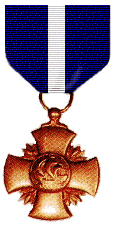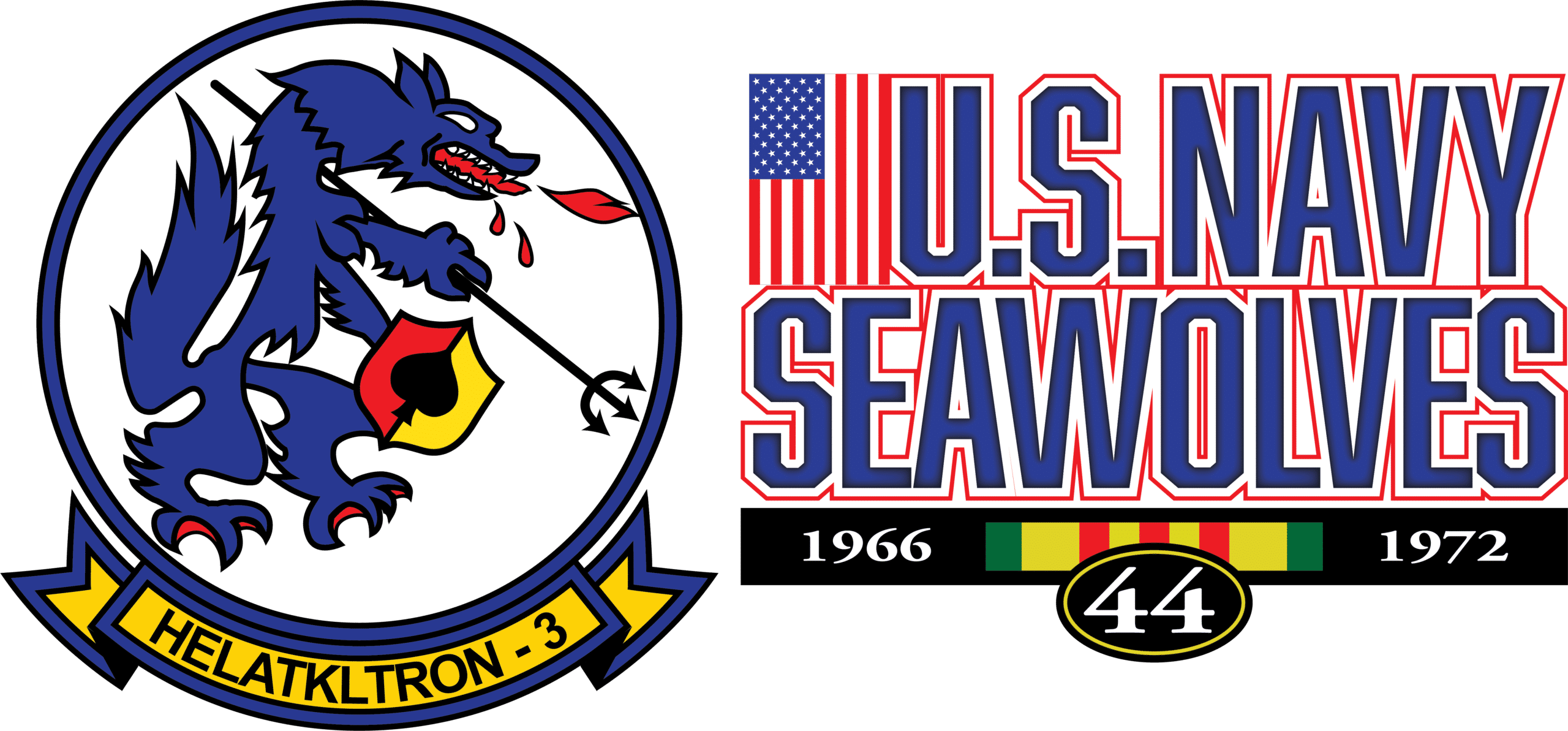 Allen E. Weseleskey, 9 March 1968
Allen E. Weseleskey, 9 March 1968
James R. Walker, 15 September 1968
Lloyd T. Williams Jr., 28 April 1969
Robert E. Baratko, 15 September 1970
Norman B. Stayton, 26 March 1971
Allen E. Weseleskey
Citation: For extraordinary heroism on 9 March 1968 while serving as an Attack Helicopter Fire Team Leader with Helicopter Attack (Light) Squadron Three in the Mekong Delta Region of the Republic of Vietnam. While attempting to rescue two United States Army Advisors who had been critically wounded when their Vietnamese battalions engaged communist insurgent (Viet Cong) forces, Lieutenant Commander Weseleskey and his helicopter fire team were caught in an intense cross fire during the attempt to land. Signaled to abort and clear the area, by ground troops, the fire team departed the zone, machine guns blazing. When his wingman’s aircraft commander and door gunner were wounded, Lieutenant Commander Weseleskey ordered them to return to base while he remained on station to complete the mission alone. Witnessing a Vietnamese aircraft receive several hits which forced it to depart station, Lieutenant Commander Weseleskey renewed his determination to complete a successful rescue of the Americans. Joined by an Army AH-1G gunship to cover his attempt, he led his crew into the combat zone, again receiving intense enemy automatic weapons and .50 caliber fire. He landed his helicopter on target, in an extremely confined zone, and brought aboard two critically wounded U.S. Army advisors and a seriously wounded Vietnamese soldier. Lifting his heavily laden helicopter out of the zone, Lieutenant Commander Weseleskey maintained absolute control of his aircraft despite adverse flying conditions. By his professional leadership and courageous fighting spirit, he served to inspire his crew to perform to their utmost capability, thus ensuring the success of the mission. His heroic actions were in keeping with the highest traditions of the United Stated Naval Service.
Details from Survivor Jack Jacobs
James R. Walker
Citation: For extraordinary heroism on 14 September 1968 while serving with Helicopter Attack (Light) Squadron Three, Detachment Three, during operations against enemy aggressor forces in the Republic of Vietnam. As a Fire Team Leader of a Light Helicopter Fire Team which was called in to support United States naval forces that were under attack on the Mekong River, Lieutenant Walker, upon arrival at the scene of the enemy ambush, immediately commenced his attacks against the entrenched hostile emplacements on both sides of the river. After diverting the intense enemy fire from the badly damages ships to himself and his fire team, he continued to press his attacks and was able to suppress much of the Viet Cong fire. With his ammunition expended, Lieutenant Walker was preparing to leave the scene of action to rearm when he was informed of the need of an immediate medical evacuation of a critically wounded crewman aboard a severely damaged lighter. Realizing that no medical evacuation aircraft could approach the crippled ship due to heavy fire, Lieutenant Walker courageously volunteered to attempt the evacuation, in the face of the withering hail of bullets, and with full knowledge that the ship had no landing capabilities for his aircraft. He hovered his aircraft over the bow of the moving ship and successfully completed the evacuation of the injured man under the most hazardous conditions. He then flew the casualty to awaiting medical attention at Vinh Long Airfield and quickly rearmed, returning to the scene of contact to press his attacks on the enemy positions. Forced to rearm once again at Vinh Long, Lieutenant Walker again returned to the ambush scene and succeeded in breaking the fiercely resisting insurgents ans suppressing all their fire. Through this tenacious and courageous attacks, he turned a well planned enemy ambush on United States naval forces into a disastrous enemy rout. Lieutenant Walker’s composture under fire, outstanding professionalism, and valorous dedication were in keeping with the highest traditions of the United States Naval Service.
Lloyd T. Williams Jr.
Citation: For extraordinary heroism on 28 April 1969 while serving as a crew chief and door gunner with Helicopter Attack (Light) Squadron Three, Detachment Three, during a strike mission against enemy sampans in the Republic of Vietnam. When the wing aircraft was struck by ground fire and crashed, and his own aircraft was also struck and forced to land, Petty Officer Williams calmly directed the preparations for forced landing while continuing to return the enemy fire. After his aircraft had landed and the crew had abandoned it, he advanced toward the enemy under heavy fire and established a defensive position on the path leading to the enemy positions. Observing a crew member from the crashed wing aircraft moving in the midst of the wreckage, Petty Officer Williams exposed himself to the blistering fire and ran across an open field to rescue the casualty. After carrying the severely injured man across the open field to an area near the defensive perimeter, Petty Officer Williams returned to the wreckage to in an attempt to find others from it’s crew. Obliged to suppress enemy fire in order to conduct his search, he persisted in his rescue attempts, despite the heat from the fire and the dangers of exploding ammunition, until his ammunition was exhausted. Petty Officer Williams then ran to the defensive perimeter to report that the enemy had started using mortars, and proceeded to assist a casualty aboard a rescue helicopter before boarding the craft himself to render first aid to the other wounded. Petty Officer Williams’ determined efforts, his indomitable courage under fire, and his inspiring devotion to duty were in keeping with the highest traditions of the United States Naval Service.
Robert E. Baratko
Citation: For extraordinary heroism on 15 September 1970 while serving as the aircraft commander of an attack helicopter, attached to Helicopter Attack (Light) Squadron Three, during operations against enemy forces in the Republic of Vietnam. Lieutenant (jg) Baratko participated in a mission to provide cover for a medical evacuation helicopter which had previously attempted to evacuate several seriously wounded personnel in the face of intense enemy fire. As his plane and three others entered the evacuation area, the surrounding treelines erupted with intense fire which downed two aircraft and seriously damaged a third. Lieutenant (jg) Baratko’s aircraft sustained several critical hits, including one through the fuel tank. With the only flyable attack helicopter on the scene, he provided gunship coverage while the medical evacuation helicopter eventually succeeded in rescuing the downed crews. As he was flying this coverage, Lieutenant (jg) Baratko’s plane was again subjected to heavy enemy fire and sustained several more hits. After the medical evacuation helicopter departed the area, Lieutenant (jg) Baratko flew to a nearby landing strip with his fuel supply practically exhausted. By his perseverance and great personal valor in the face of almost overwhelming odds, he was directly instrumental in saving the lives of several of his shipmates. His selfless and determined efforts were in keeping with the highest traditions of the United States Naval Service.
Norman B. Stayton
Citation: For extraordinary heroism on 26 March 1971 while serving as second gunner in the lead aircraft of a light fire team from Helicopter Attack (Light) Squadron Three, flying convoy escort along the Can Gao Canal, Kein Giang Province, Republic of Vietnam. Petty Officer (then Airman) Stayton was participating with his fire team in providing overhead cover for a boat convoy when one of the boats carrying 9,000 gallons of explosive jet fuel struck a mine, detonating the fuel. Two enemy rockets then struck the boat, following which burning fuel spewed across the water. When he observed a wounded man struggling to shore to escape the flames and the hail of enemy bullets hitting the water, Petty Officer Stayton alerted his pilot, took the initiative and dived from the hovering helicopter into the burning canal to carry a life preserver to the survivor. Although immediately wounded in the leg, Petty Officer Stayton nonetheless succeeded in reaching the victim, who had sustained serious burns and was in a state of shock, and shielded him with his own body while attempting to tow him to a recovery site. Thwarted in five attempts to reach the hovering helicopter because of the current, the enemy fire, and the helicopter downwash, Petty Officer Stayton, although close to complete exhaustion, managed to wave his arms and get the attention of a river assault craft which proceeded to rescue both men. By his valiant and persevering efforts in the face of intense enemy fire and almost insurmountable circumstances, Petty Officer Stayton was directly instrumental in the rescue of a seriously wounded fellow serviceman. His heroic actions were in keeping with the highest traditions of the United States Naval Service.
